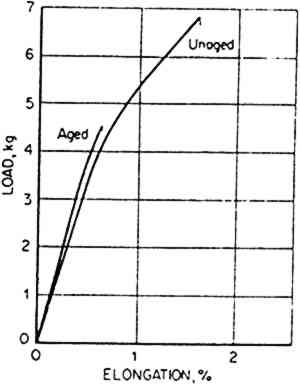RECENT SCIENTIFIC RESEARCH IN PAPER CONSERVATIONDIANNE VAN DER REYDEN
3 AGING OF PAPERThe primary concerns of research on the aging of paper involve determination of 1) the effects of natural aging on paper and 2) the parameter of accelerated aging that most nearly match the effect of natural aging on paper. 3.1 NATURAL AGINGNatural aging may cause paper to become discolored and cellulose to become more crystalline and stiff, as has been shown for accelerated aging (fig. 5). Crystallinity can be measured by x-ray diffraction, acid hydrolysis, or moisture content, although the percent crystalloids depends on the method used and on interference of additives (Daniels 1986). Koura and Krause (1987) concluded that, based on changes in mechanical properties, treatments using ammonia could reverse the degree of crystallinity in aged papers. Discoloration of a paper sheet may be caused by the formation of chromophores upon aging as a result of exposure to, among other things, light (Lee et al. n.d.) and volatile gases (Daniels 1988). Daniels has hypothesized that oxidation can be induced in paper by hydrogen peroxides from oxidation of lignin, leading to autoxidation of paper (Daniels 1988). He has described how hydrogen peroxide can be recorded by the Russell effect, which produces an image on sensitive photographic film. More recent studies have focused on the effects of pollution on aging of papers, particularly deacidified papers, which appear to have a greater capacity to absorb sulfur dioxide and nitrogen dioxide (G.C.I. Newsletter 1990).
3.2 ACCELERATED AGINGAccelerated aging, undertaken at elevated temperatures and humidities, may initiate reactions resulting from thermal degradation. These reactions could, depending on conditions and length of exposure, produce products different from those of natural aging (Feller 1987). Erhardt has used gas chromatography mass spectrometry to analyze extracts of papers aged at different temperatures and relative humidities. He found that humid oven aging of Whatman #1 filter paper (at 90�C and 100% RH) hydrolyzed cellulose and xylan, producing mostly glucose and xylose, also found in naturally aged papers. Dry oven aging at 90�C and above produced very little glucose. Aging at 150�C produced a different set of products (Erhardt et al. 1987; Erhardt 1988). Other researchers have focused on the effects of cycling aging conditions, finding that cycling relative humidity increases the degradation of single sheets of paper (Shahani et al. 1989). However, the effects of cycling appear to be less pronounced for books, the format of which may slow down changes. On the other hand, simulated book materials tend to age faster in comparable accelerated aging conditions than do single sheets, perhaps owing to the trapped concentration of degraded materials forming what amounts to an adverse microclimate. As noted by Erhardt (1988), there are many standards for accelerated aging applied to paper. For instance, TAPPI test methods lists three different sets of conditions ranging from 90–105�C and 0–100% RH depending on the type of papers and property to be measured, while ISO requires 80�C and 65% RH. In general, a wide variety of aging conditions continue to be used in current research, including the studies described in the following section. |
